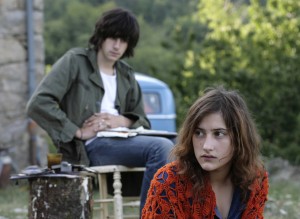France, around 1971: bohemian kickback, heroin flowing, bonfires blazing; nude or half-nude, the Marxists-maybe-Maoists dance, music booming, politics looming. Embers flicker in the air, romance, youth and ennui and smoke, tasseled together inseparable, floating ethereal into nevermore.
Such are the languid memories of Olivier Assayas, whose latest feature “Something in the Air” is brimming with candid and semi-lucid anecdotes about French youth after the May ’68 student protests.

Assayas finds his surrogate in Gilles (Clément Métayer), a high school student who loves painting and cinema and dabbles in graffiti and Molotov cocktails. It would be inaccurate to say that he falls in with the revolutionary crowd. But it would be equally misleading to say that he joins it. Nothing about the beginning of his career in rebellion is spelled out – he’s just one of them, as if it were but a fact of life.
This creates a particularly effective portrait of just the actions – the day-to-day of being young and radical, divorced from coherent motivation or ideology. Indeed, scenes where it might be logical to elaborate on specifics are more interesting for their character dynamics.
There’s an especially funny scene early on about underground pamphlet production, where students gather in the basement of one of their parents’ houses to print obscene political material. The well-meaning dad comes in to check on his darling idealists, only to react in disgust to their creations, and they reply, “We are questioning the moral order! We are fighting sexual repression!” as if it were the most natural thing in the world.
This sometimes ridiculous mix of the political and the personal drives the plot proper of the film forward in somewhat predictable fashion. Gilles soon gets caught between two deeply symbolic women: Laure (Carole Combes), a free soul symbolizing his inner desire to be an artist, and Christine (Lola Créton), a sincere socialist representing his politics. When Gilles discusses propaganda films, Assayas gets to the core of his preoccupations: between personal obligations and societal ideals, between revolutionary art and revolutionary actions.
Poignantly enough, the film itself is decidedly not revolutionary. It’s gorgeously shot, assuredly paced and moment-to-moment interesting, but in the end only Créton’s performance stands out – at once sympathetic and pitiable, worthy of revolution but destined to do without it. The style is astonishingly normal for Assayas: well-mounted, tripod dependent, no absurd time-jumps or color-coded surrealism. It’s plot product par excellence and little else.
So when Gilles goes to pursue his dreams at a low-budget B-Movie studio, one can already tell where his career will go. He tries to find middle-ground between his art and his politics, but neither can sustain compromise – the folly of youth is inevitably absorbed into the pragmatism of age. Laure haunts him in experimental films, Christine lingers like regret, and all he got out of it was exactly the kind of film he abhorred.
It’s an almost cruel joke: One compromise leads to another, and if there was ever a revolutionary he exists only in memory now.
